It seems like just yesterday that Florens 2010 brought a lawn to Piazza del Duomo and a full-sized David moved from place to place around Florence. For the second edition of this global cultural event, the city is graced with seventy olive trees forming a grove around the Baptistry and three historic crucifixes inside. Across town, the piazza in front of Santa Croce, as if by magic, has grown a cross of its own, made of tons of marble.
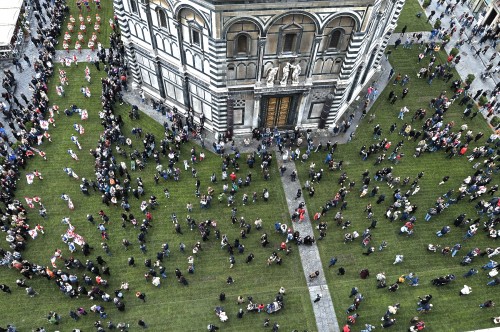
The olive grove is best seen early in the morning or late at night when the fewest people are around. The trees are only a small part of Florens 2012. Every day this week there are lectures, bloggers, food and wine.
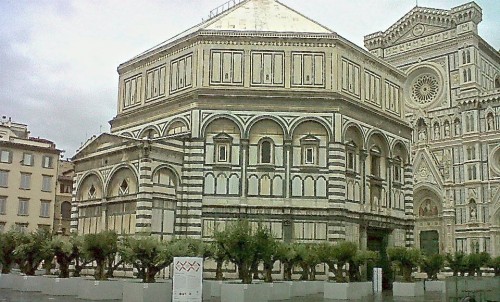
Many of the olive tree are over 100 years old. Those made up of three or four twisted trunks are really branches of a tree that survived the 1985 deep freeze that turned the Arno to ice.
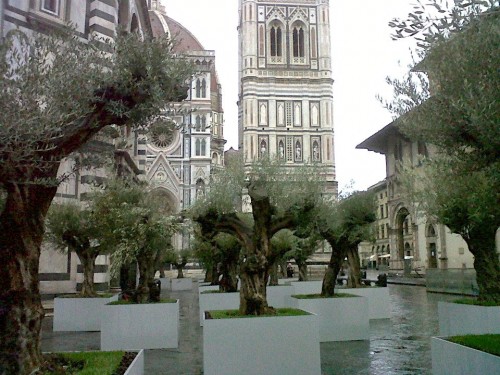
Florens 2012 tries to mix the references to the Garden of Gethsemane with environmental concerns of today. Neither symbol comes to mind as you wander through the trees.
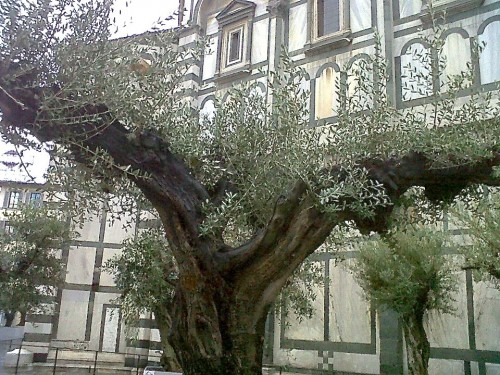
In 2010, the Prato was in honor of Saint Zanobi, but most people just enjoyed the rare feel of grass in this city of stone. These ancient pruned olive trees may only make you think of the drought-caused blight on the 2012 olive harvest and wonder about the high price a liter of extra virgin cold pressed oil will cost in January 2013.
As you move inside the Baptistry, the Garden of Gethsemane gives way to the crucifixion with never-before gathering of three wooden sculptures by Florence’s favorite sons – Donatello, Brunelleschi and Michelangelo.
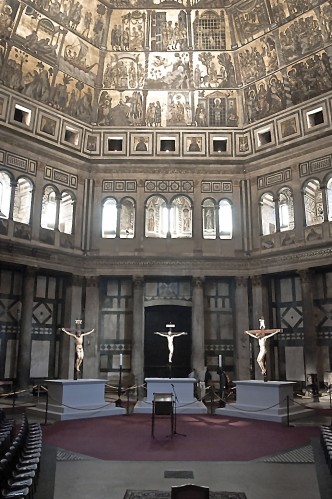
The exposition is know as Mysterium Crucis or Mystery of the Cross. Florens 2012 casts its eyes back 1,700 years (only in Italy can you get away with that) to Emperor Constantine, who in October 312 (they are precise about the month and year) at the Battle of the Milvian Bridge, saw a cross accompanied by the words in hoc signo vinces (in this sign you win). The curators ask you to bring your thoughts forward to the meaning of the cross today.
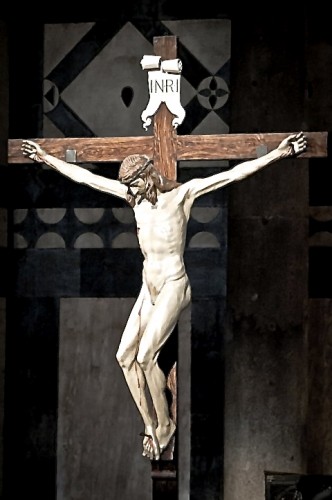
But you may just want to stop and think about the artists who, each in different decades of the 1400s, carved such masterworks out of wood. Each artist had a very different vision and style, but each was influenced by the iconography and customs of their time.
Michelangelo’s sculpture is the most shrouded in mystery. Supposedly carved for the prior of Santo Spirito, this 1492 crucifix, was rediscovered in 1962, but not attributed to the artist until 2001.
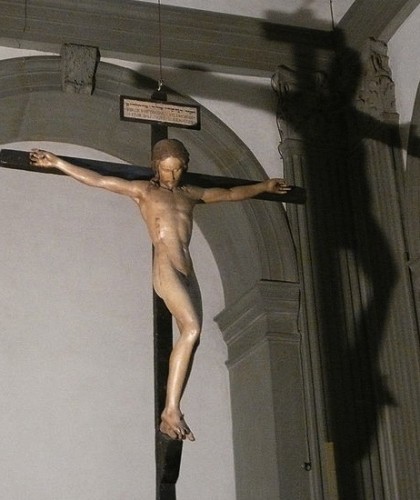
If art historians have it right, Michelangelo was still a teenager when her carved the crucifix hanging today in the Baptistry. The delicate carving is interesting in comparison to Donatello’s (1413), which was not appreciated by his contemporary, Brunlleschi, who thought the life-like face of Donatello’s Christ looked more like a peasant.
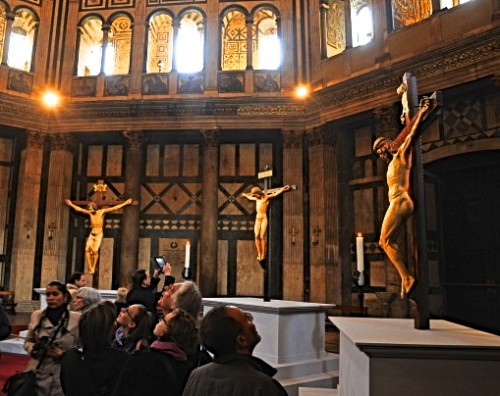
Moving on to the modern, you must walk across town to Piazza Santa Croce where Mimmo Paladino has hauled in tons of marble to create a cross of his own. This is a very interactive piece with people actually encouraged to write on the gorgeous marble’s creamy white face. Art in public spaces is a theme of this piece, although you might wonder how the gold leaf fluttering off one of the blocks is going to last out 24 hours.
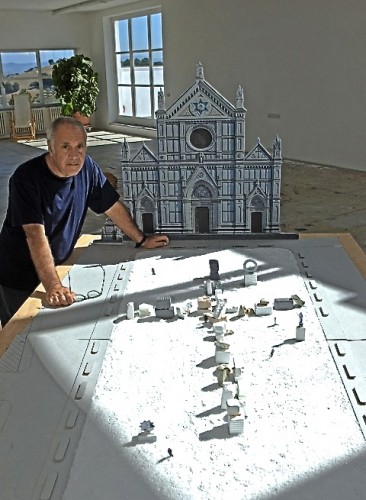
Paladino’s cross includes bronze pieces – body parts, large geometric shapes – as well as monumental carved pieces of stone that are attached to rough-hewn block of marble, seemingly just cut out of the hill-side in Carrara.
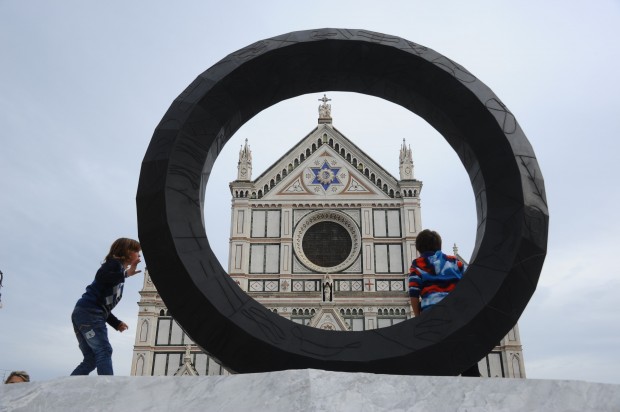
Part of the public interaction is to scale the heights of these blocks. Only in Italy, it seems. In the U.S. there would be at least warning signs or signed releases-of-liability or, most probably, a high fence.
Another aspect of the planned interactiveness involves a a stone cutter who goes around carving out the graffiti left by passers-by. The “I luv Mario” and “Forza Viola!” are now carved into the stone for perpetuity or at least until it is sanded down after the exhibit is removed from the piazza.
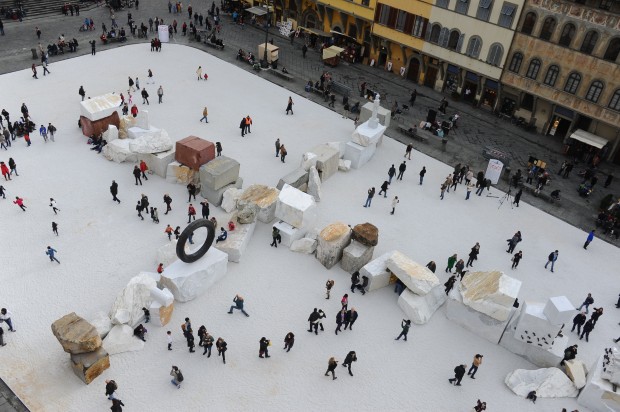
The Santa Croce installation provides the most Kodak moments. It is also the event you will have wished you had seen from the moment the first stone arrived until the last one is removed on November 11, 2012.
